The Wipers Times Exposé: The Actor, Avesnes, and the Forgotten Evening Edition of the Wipers Times
In my last piece, about the Printer and the Presses , I mentioned that I had come across a signpost in the second to last issue of the Wipers,now named the Better Times, in relation to the printing of the final two issues. This was the signpost:
Our new paper is born in very different circumstances to the old Wipers Times, and it is strange that we should get our new outfit during an advance over the same country in which the old ones was lost last March. We are the gainers by the exchange, as the new one is a much finer machine. Yet the old one held many memories for us, and we did not enthuse over losing it. Within four days of capturing the town where we found the new press we brought out an evening paper called the Avesnes Advertiser.1
On my first read through — and I am sure I am not alone in this — I thought the idea of there being an evening edition was a bit of a yarn, as it does not appear in the any of the so-called 'Complete Series' facsimiles of the Wipers, nor had I come across any further mention of it over the course of my research. But, from having spent time researching the people involved, while there is some spin and exaggeration involved, overall, it is more a stretching of the truth — as I have been able to find a root for many of the claims made. With that in mind, on my second read, I decided to treat the existence of an evening edition as a fact, and therefore wondered what became of it. One thing those involved with the Wipers were very good at —and consistent about — was sending copies to, well, everybody. Additionally, by this time in the war, the business of collecting trench journals had become a serious affair, discussed briefly in part one of this series, and a new entrant in the collecting business was the Imperial War Museum, founded by the War Cabinet in 1917, with the librarian of the museum putting out a specific call for trench journals for their collection.
I planned to see whether a copy existed first in the British Library; failing that, I tried the excellent collection of Francis Jenkins at the Cambridge University Library; and then the Imperial War Museum. Unfortunately, all these possibilities turned up blank.
However, I did come across an index to Cassell's Magazine, a pulp magazine carrying short fiction and non-fiction, and the entry for volume 224, November 1930, read:
- Page 20. A Contemporary of the Wipers Times by Colonel F.J. Roberts.
- Page 22. Producing the "Advertiser" by J.O. Twiss.
- Page 23. The Avesnes Avenues ed. J.O. Twiss, this is a facsimile reproduction of the only issue of the wartime companion to the Wipers Times dated 16 October 1918.
I also managed to find a scan of the front cover for this issue.2

There were also entries for another couple of articles written by Colonel Roberts (volume 225 — 'Christmas cards at the front', and volume 230 — 'Oh! Those war books!'). While the British Library might not have the Avesnes Advertiser, they should hold copies of Cassell's magazine.
At the start of October, I reserved the above-mentioned volumes, and just as I was about to head out to the library, on checking my reading room requests, I came across those dreaded words: 'items mislaid'. Then, when I turned up at the library — as there were a few other publications I was researching — I was handed a notice saying volumes 224 and 225 were not actually mislaid, but rather there was a gap in the collection.
Feeling a bit downhearted on my return — for various reasons I had delayed my visit several times — and fearing this was a dead-end, I edited the draft of this article as a biography of Twiss and an appeal to track down the missing issue.
However, the website on which I found the index to Cassell's, Galactic Central, had a mailing list, which I joined, as it a great source on popular fiction, especially a handy resource as I inch towards my PhD.
I mentioned on the list that I was looking for the issue in question, and the Science Fiction author and bibliographer Mike Ashley got in touch. As a result, I am now the excited owner of issue 224, and I can now share the forgotten evening edition of the Wipers Times, presented below, and the story behind it.
J.O. Twiss
Josiah Oliver Twiss (1888-1966), known as J. Oliver Twiss, and later J.O. Twiss, was born on 10 February 1888, in Barrow-in-Furness, Cumbria. His father, also named Josiah, was the owner of the town's Duke of Edinburgh Hotel, which still stands today, and would pass away from illness in June 1899 at the age of 48.3 There was a dispute about his estate which ended in the court under Twiss vs Twiss. The deceased had appointed his widow, Sarah Twiss, and friend, H. G. Pearson, as trustees. Sarah put in an application, as a trustee, to buy the Hotel for £1,000, which was sanctioned by the court. However, James Ramsay, appointed by the court to act as next friend (a legal term for a representative in court for those who are underaged or not competent) to the three Twiss children, sought to have the sale set aside due to undervaluation. There were then accusations of fraud and the suppression of information, which were later dropped, and the court eventually ruled that Sarah could buy the hotel for £2,500 with the judge satisfied that she and Pearson had not acted in bad faith but had proceeded on an erroneous basis due to a mistake by the valuers.4
J.O. Twiss attended Holker Street School and would go on to study English, maths and French at the University of Glasgow circa 1904-1908.5 During the First World War, he originally joined the Sommerset Light Infantry (date unknown, service number 33375), and was later commissioned as a Second Lieutenant in the 3rd Battalion Sherwood Foresters and transferred to the 12th Battalion on 31 October 1917.6 He was sent to France in April 1918 — and in terms of the Wipers timeline, this is one month after their press had been destroyed in the Spring Offensive, and six months out from them obtaining a new press and printing the first issue of the Better Times.
The Actor
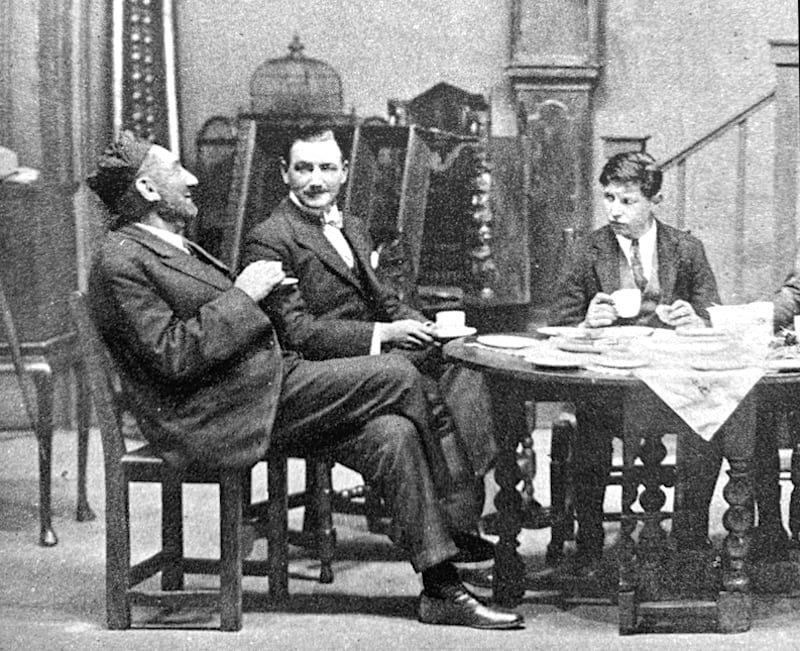
The earliest mention of Twiss's acting career is a preview of the play The Spy Peril (Alhambra Theatre, Bradford), on 22 August 1914.7 The play is a tale of British secret agents pitting their wits against the German Secret Service. On the Bradford run, Twiss (billed as J. Oliver Twiss) played a supporting role as one of the British Secret agents, and when the play transferred to the Palace Theatre (London), Twiss was cast in the main role of Professor Blackhurst, a German secret agent making bombs in his quiet English country home.8 Throughout the rest of 1914 and 1915, his name appeared in numerous theatre listings across the UK, in The Gentleman Banker (Metropolitan Theatre, London), The Risk (Palace Theatre, Cork), and The Kiss Cure (Croydon Hippodrome, Surrey) to name a few.9 In 1916, he made his debut as a playwright with the comedy Magnificent Mac at the Royal County Theatre (Kingston-upon-Thames).10 The play tells the story of an artist who, under financial pressure, turns burglary into a fine art.11 The play went on a nationwide tour and was still being performed a year later.12
The Bandmann Circuit
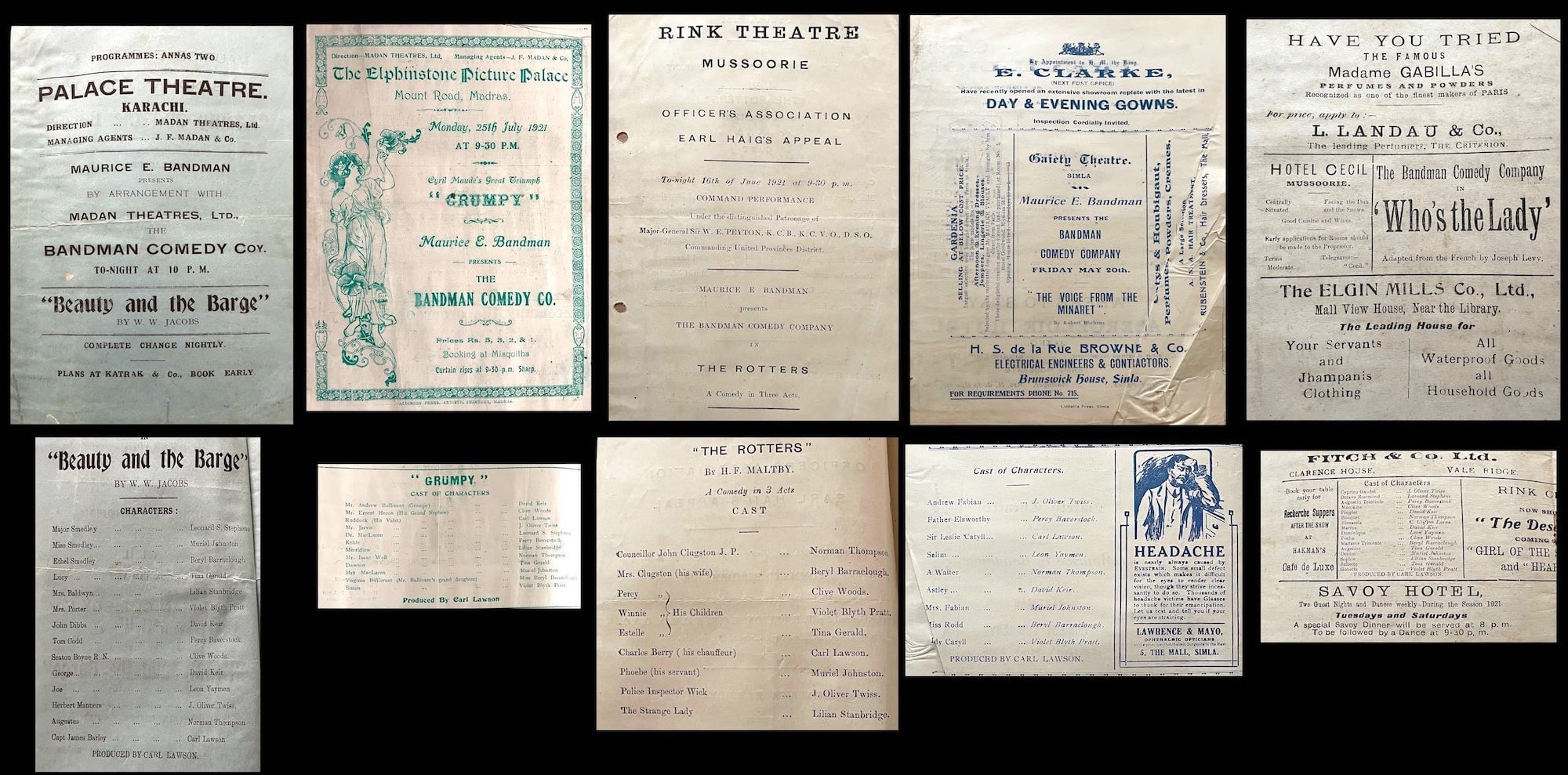
Post war, at the start of the 1920s, he toured with the Bandmann Comedy Company, part of Maurice E Bandmann Enterprises, which performed on what was known as The Bandmann Circuit. This was made up of theatres in over two dozen towns and cities, between Gibraltar and Tokyo, with occasional forays into the West Indies and South America.13 This was impressive, both in scale and logistics, as it involved long trips both by boat and overland — a member in the company would except to spend 10 weeks a year traveling.14
While in India, Twiss performed in productions such as: In the Night (Empire theatre, Lahore), Beauty and the Barge (Karachi, Lahore), and Grumpy (Elphinstone Picture Palace, Madras).15 Alongside Twiss in these productions was Violet Blyth Pratt (1900-1976); while passing through Calcutta, the two were married on 16 June 1920.16 From there, they proceeded to Burma, and then on to Shanghai to start a tour of China.17 Here, they would perform in no less than 17 different productions, including The Naughty Wife by Frederick J. Jackson, with Twiss taking the lead role (made famous by Charles Hawtrey) of Hilary Farrington — a role he would repeat later in the decade and across the world.18 It was expected that members of the company would each master up to 20 roles, and the cast, in large cities like Bombay, were expected to perform a different production every night.19 Part of the modus operandi of the company was to bring the latest London plays to the colonies — given these tours would last up to 18 months, the number of plays rehearsed and performed was probably higher.20 In addition, individual plays were 'calibrated' for each region, to not upset local customs and to adhere to local regulations — which must have required a fair amount of mental gymnastics from the cast.21
As an actor on the circuit, as well as the gruelling mental demands, with rehearsals taking place daily and performances in the evening — including the occasional matinee, and vaudeville performance — it was also taxing from a physical standpoint, with the travel, performances, and having to adapt to a wide range of different climes with the background risks of malaria and dysentery.22
The reward and attraction were economic. A member of the cast could expect to earn between £5 and £12 a week — a top performer might be able to command a salary of £25, with the average being £8, or £336 per a year (time spent traveling was unpaid).23 Not only was this a regular income for an actor — a rarity — it was also higher than London theatre wages, and higher than the average annual wage of the UK at the time, at around £130-160.24 The risk, however — beyond exotic diseases — was that while an actor was touring, they were missing out on building their London reputation.25
London Career
The potential negative career effects of the itinerant acting life didn't seem to effect Twiss: on his return to the UK in 1922 there was a whirlwind of activity. His career as a playwright continued with The French Dancer making its debut at the Gaiety Theatre (Hastings) that year. He also became a director of the theatre company Roland Productions Ltd in 1923, and his name is on several song copyright registrations, contributing to lyrics and verses — though the titles and lyrics of these songs are best left in the past.26 He continued to perform and tour regularly in such productions as the highly-regarded Love in Pawn (Kingsway Theatre, London), the George Bernard Shaw biopic Saint Joan (Pleasure Gardens, Folkstone), and the melodrama Mrs Dane's Defence (Opera House, Manchester). 27
In 1925, Violet petitioned for divorce, and around this time he also dropped the Oliver from his name, being credited as J.O. Twiss on playbills.28 At the close of the decade, he was on a nationwide tour of Simon Ord's Marigold: An Arcadian Comedy, playing the role of Major Andrew Sellar, to rave reviews.29
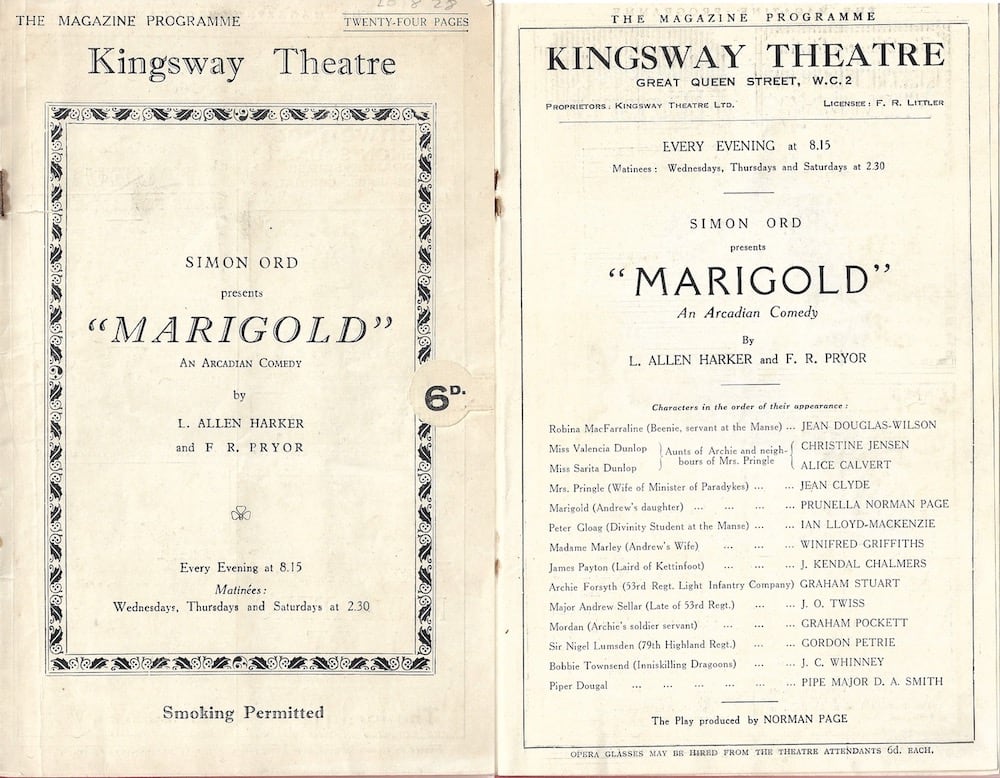
At the start of the 1930s, his play The Red Dog, a farce set in an exotic French night club, debuted at the Streatham Hill Theatre (London) before going on to the West End. The play would later be adapted into the 1932 film Pyjamas Preferred starring Betty Amann.30
Heritage
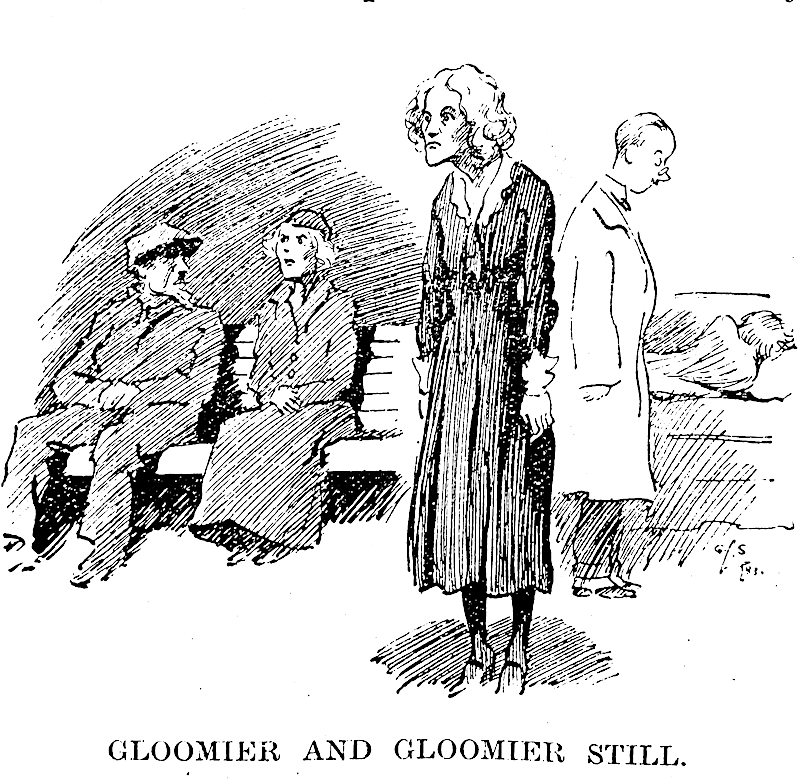
In the same year, he would write and produce the play Heritage, which debuted on 14 July 1932 at St. Martins Theatre, London.31 The first thing to note, in terms of theatre at the time, is that the play unusually had a cast of 42 and consisted of five episodes in the first half, followed by five sequels in the second half — presented in a series of flashbacks.32 The play is billed as a 'modern problem play', dealing with the subject of 'inherited traits', and one reviewer described it as 'this is not so much a play as an impassioned plea from the stage for the sterilisation of the unfit'.33 Another reviewer wrote: 'If all playgoers were like me, there would be no money in Mr. J.O. Twiss's depressing play'.34
But the play also had its fans and it attracted the attention of the Eugenics Society, which would go on to fund a West End run, followed by a national tour through 1933, and again in 1938.35 For context: the subject of eugenics had become a popular topic in the late 19th century and gained a sheen of legitimacy with the formation of the Eugenics Education Society in 1907, along with the establishment of the Eugenics Laboratory at the University of London.36 This is a topic that deserves its own post, and will be covered as part of my AYIT series in the future. Post-war, eugenics formed part of the 'Lost Generation' narrative, attracting those who saw Britain having lost its best elements of society during the war to the cause.37 The important thing to note in this short space, is that while eugenics was widely discussed, and had its political supporters (such as Alfred Balfour and Winston Churchill), it was never a movement — the supporters were made up of small sections of the professional middle-class and the ruling class. There were plenty of opponents and critics, such as the Catholic Church and the Fabian Society.38
Whether Twiss held the views expressed in the play or was simply producing a play that he knew would cause controversy is entirely unknown.
Later years
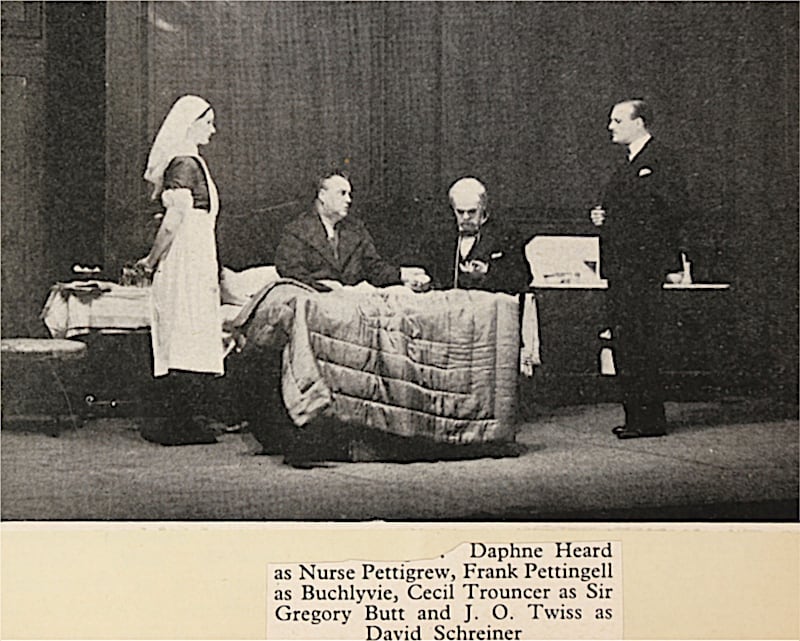
One of the actors in Heritage was Jessie Belmore (1890-1971), a former Tiller Girl, born into the infamous Belmore theatre family.39 Having been married to the actor Louis Hector Niblett — whom she divorced in 1932 — and after a revival of Heritage in 1938, Belmore became Twiss's second wife in 1939. The two enjoyed a co-writing and management relationship, putting on short farces, like the The Film Extra, at venues such as the Whitehall Theatre (London).40
As well as acting, writing, and producing, Twiss had a patent to his name, registered in 1936, involving a horse racing game. From the patent's description, it involved a base board, with slots for wooden horses, attached to a wire underneath. The player has to pluck the wire, which causes the horse to vibrate, and move along it. 41
By the end of the 1930s and into the 1940s, the Twiss name still appeared regularly on playbills. Now in his 50s, he was to be found more in supporting roles, appearing in plays such as The Tender Age (Embassy, London), The Racketeers (His Majesty's Theatre, Aberdeen), and Lottie Dundass (The Vaudeville, London), and was still drawing favourable reviews for his performances. 42
In 1944 Twiss landed the role of Squadron Leader Briarly in R.F. Delderfield's Worm's Eye View, a play about three RAF airmen who are 'unwilling and unwanted billetees' in a country house, which debuted at the Wolverhampton Grand Theatre, then moved to the Whitehall Theatre in 1945. It would become one of the longest running plays of the time, with over 2,245 performances by 1951. A film version, staring Ronald Shiner, Garry Marsh and Diana Dors, was made in the same year. While Twiss did not reprise his role in the film, part of his stage performance of the play appeared in the short film Rise and Shiner in 1948.43 Also in 1951, Twiss appeared in the BBC television movie Nocturne in Scotland, a biography of Chopin's time in Scotland, playing the role of Elphinstone Whibley, alongside John Baker, Hugh Burden and Patrick Macnee.44
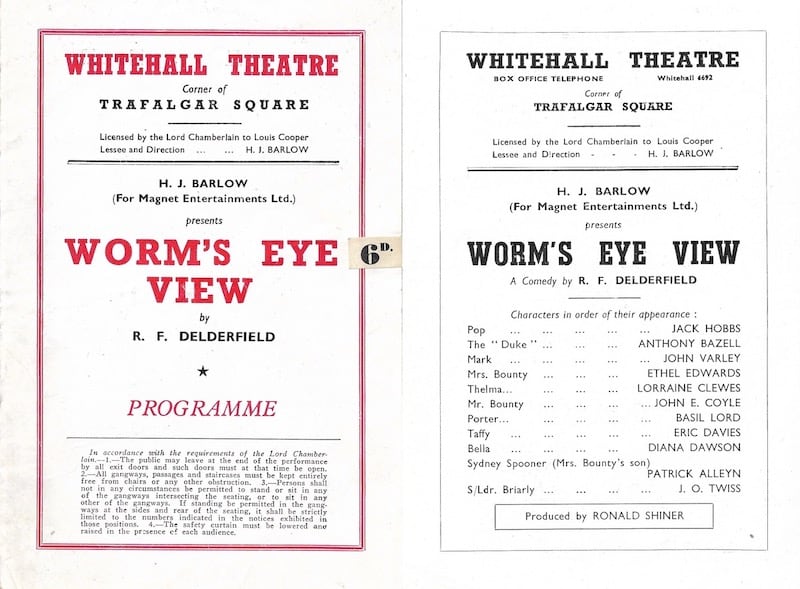
By the 1950s, Twiss's name had begun to fade from theatre playbills; his output then seems to have focused on putting on short one-act plays with his wife Jessie Belmore at the Interval Club, 22-23 Dean Street, London.45 The club was founded by Mrs Balvaird Hewett in 1926, funded from the profits of the Catholic Actors Guild, and was a meeting place for Catholic Artists in the theatre, where 'no one should feel unwanted or alone'.46 From researching Twiss's life, and from following the theatre world over the span of 30 years, this period feels sad — not only for him, but for those around him, as an entire industry fell into the shadows of the cinema, radio, and television. Within those shadows, the old guard was cast aside for a new generation. Jack Osborne's Look Back in Anger debuted in 1956, marking the start of new wave of theatre — one that inaugurated 'kitchen sink realism' and 'angry young men', entombing the country house melodramas and happy-go-lucky farces of Twiss's era firmly in the past.47 It was a time of being forgotten; Twiss had to write to the Stage in 1955 to point out that his wife was still alive after an article about the death of actress Daisy Belmore (1874-1954) was titled 'The last of the Belmores'.48 After having his name appear frequently in both national and regional newspapers over four decades, this would be the last time Twiss's name appeared in the press.
Twiss spent most of his London life at Flat 44, Burleigh Mansions, Charing Cross Road — where the building's colourful residents could fill a book of their own, counting among their number the showman behind the infamous 'Midget Town', John Lester, and the producer and political fixer Maundy Gregory, rumoured to be involved with the Zinoviev scandal (1924).49 Twiss moved to the quiet Sussex suburbs in 1959 and later, in 1964, to Wanstead. He would die two years later, on 8 June, at the age of 78.50
With thanks to Vanessa Lopez for sharing the theatre programmes of her grandfather, Stephen Lopez (1877-153), who was the theatrical production manager for the Bandmann company.
Producing the Avesnes Advertiser
From the two articles accompanying the facsimile reproduction in Cassell's, the first by Colonel Roberts, the second by J.O. Twiss.51
Roberts admits, in the opening, that he had very nearly lost sight of the publication, as it was produced in a rush in the final months of the War and remembered too late to include in the 1930s facsimile edition of the Wipers. If it hadn't been for Twiss, it would have remained forgotten, and Twiss may have had the only copy in existence.
He then recalls how the division were in Avesnes-Lez-Aubert in October 1918 and the men had come across a small printing works in a side street, which was bought to his immediate attention. Being occupied with 'other business which seemed urgent' (an understatement, as the Battalion diary notes he was appointed the Area Commandant three days earlier52). He seconded Twiss to assemble the materials and men to produce an evening one-page Special which would herald the upcoming successor to the Wipers (The Better Times), and it needed to be out by 6pm the same day.
Of note, Roberts mentions that the printshop became a godsend for the division and was well used by every unit for all types of printing — including sports programmes (Figure 8) — and Twiss came up with the idea of making printing blocks for illustrations by using marble, candle grease and sulphuric acid (DIY lithography).53 Roberts signs off with how, at the time, German prisoners were streaming back in their thousands, which he found 'particularly upsetting to the proper conduct of warfare to have the enemy wandering about in your own lines demanding to be taken prisoner', before closing by saying that the horse racing meets, particular those with the Transport Mules, were 'particularly hazardous as speculative mediums'.
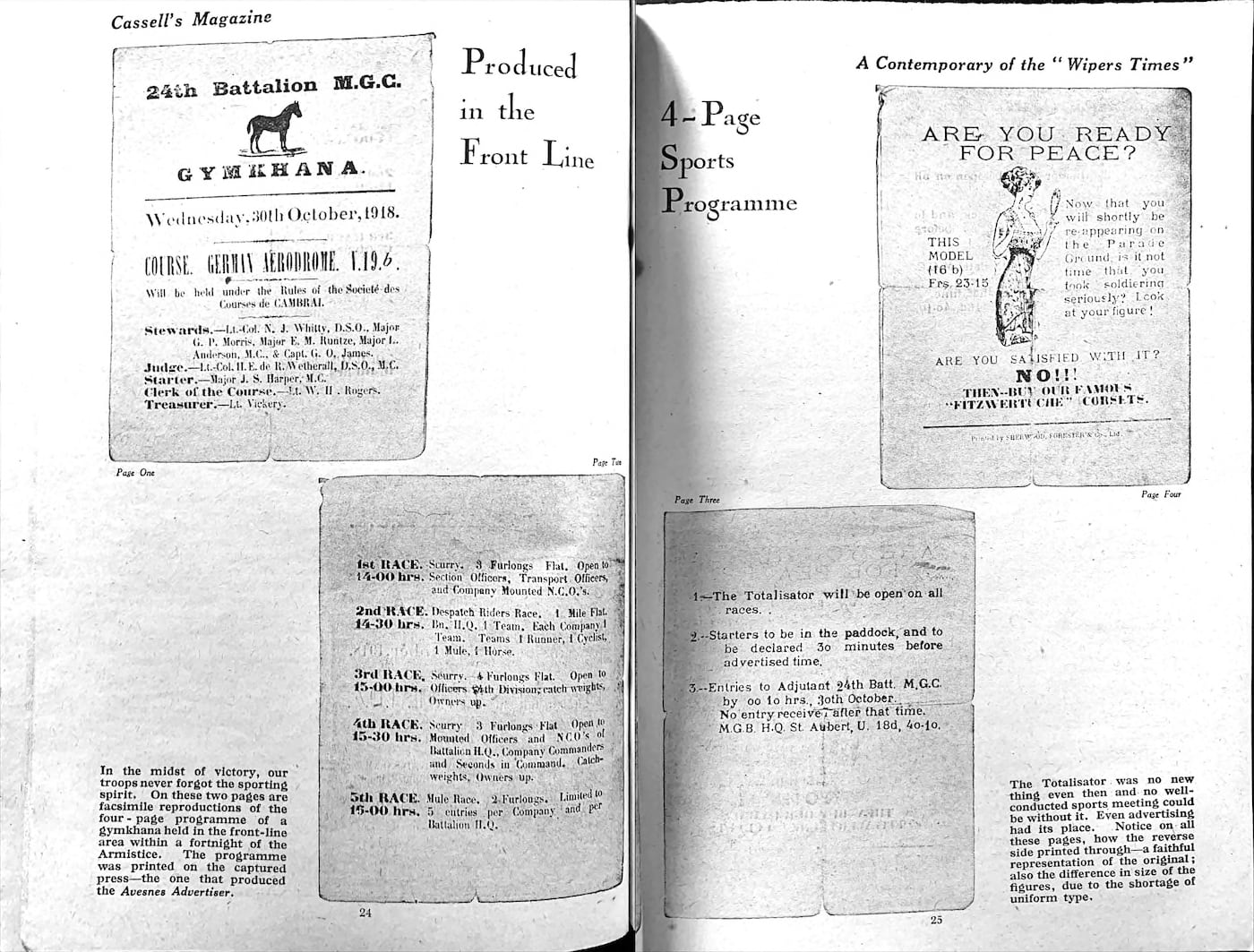
Twiss is then introduced, and a plug for his play, The Red Dog (mentioned above), is given in the intro. Twiss opens by saying he is surprised that Roberts had forgotten the existence of the Avesnes Advertiser, as 'rushing out the special was, to my mind, sufficiently remarkable to be a war-time landmark', adding that Roberts' forgetfulness was even more surprising as Roberts had provided all the copy for the issue.
Twiss picks up the story in Avesnes, and on being made the 'Office in Command of the Printing Press', he writes: 'I am told that the make-up of a modern newspaper is considered a very important matter. In the rush to get out the Avesnes Advertiser on the very same day that the printing works were "purchased", the matter of "make-up" was a very secondary consideration'.
Twiss then reminds the reader that Avesnes had only just been taken back from the enemy, and all the lead printing type had been heaped into a pile by the Germans to be carted off and recycled into ammunition — which was not without precedent: back in 1915, during the shell crisis in Britain, printers' type was recycled for the same reason.54
The printing works, from having been shelled, were not in a particularly orderly or healthy state, and the aroma from a recently exploded gas shell hung around, which prevented anyone from staying there for any length of time. The compositors got to work sorting through the pile of type, and after several hours had enough of 'a similar size' for the paper. Some cheap paper was found, thanks to a diligent scrounger, along with an unbroken bottle of ink.
On the printing, Twiss writes:
The First "pull off" under these circumstances was, as you may guess a critical moment. But the C.O. refused to be thrilled grousing, at twenty-five to six, 'Come along, you fellows, you're wasting time! I've promised Division to have the special out by six pip emma! You're holding up the whole war!
Then to cramp our style, C-r-r-ump! C-r-r-rump! Hun "Heavies" began to fall.
But the printers had served on the old Wipers Times! Falling shells meant neither printers' errors — nor printers' terrors — to them.
That "special" was out to schedule, and on sale by one minute to six!
The Avesnes Advertiser, 16th October 1918
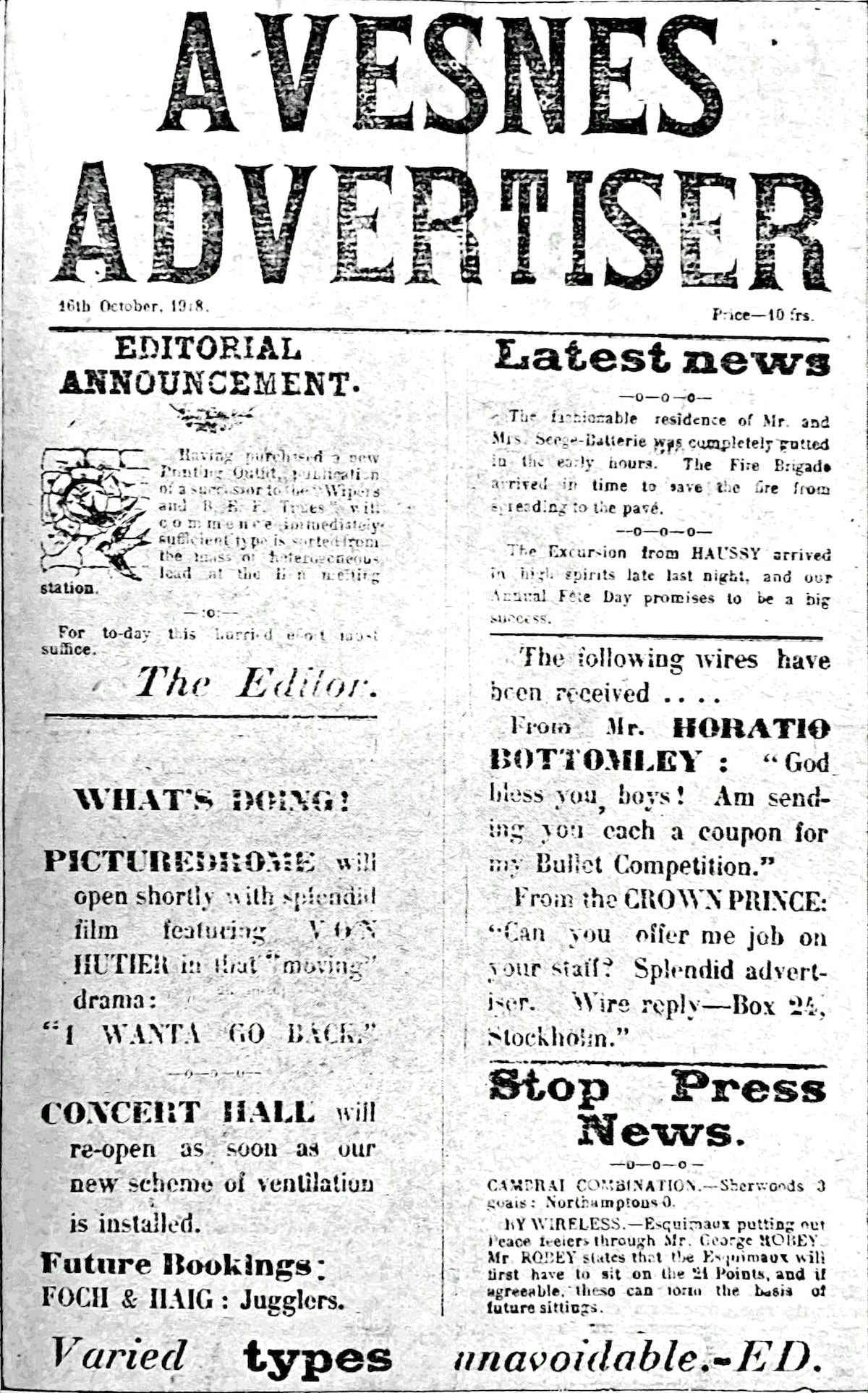
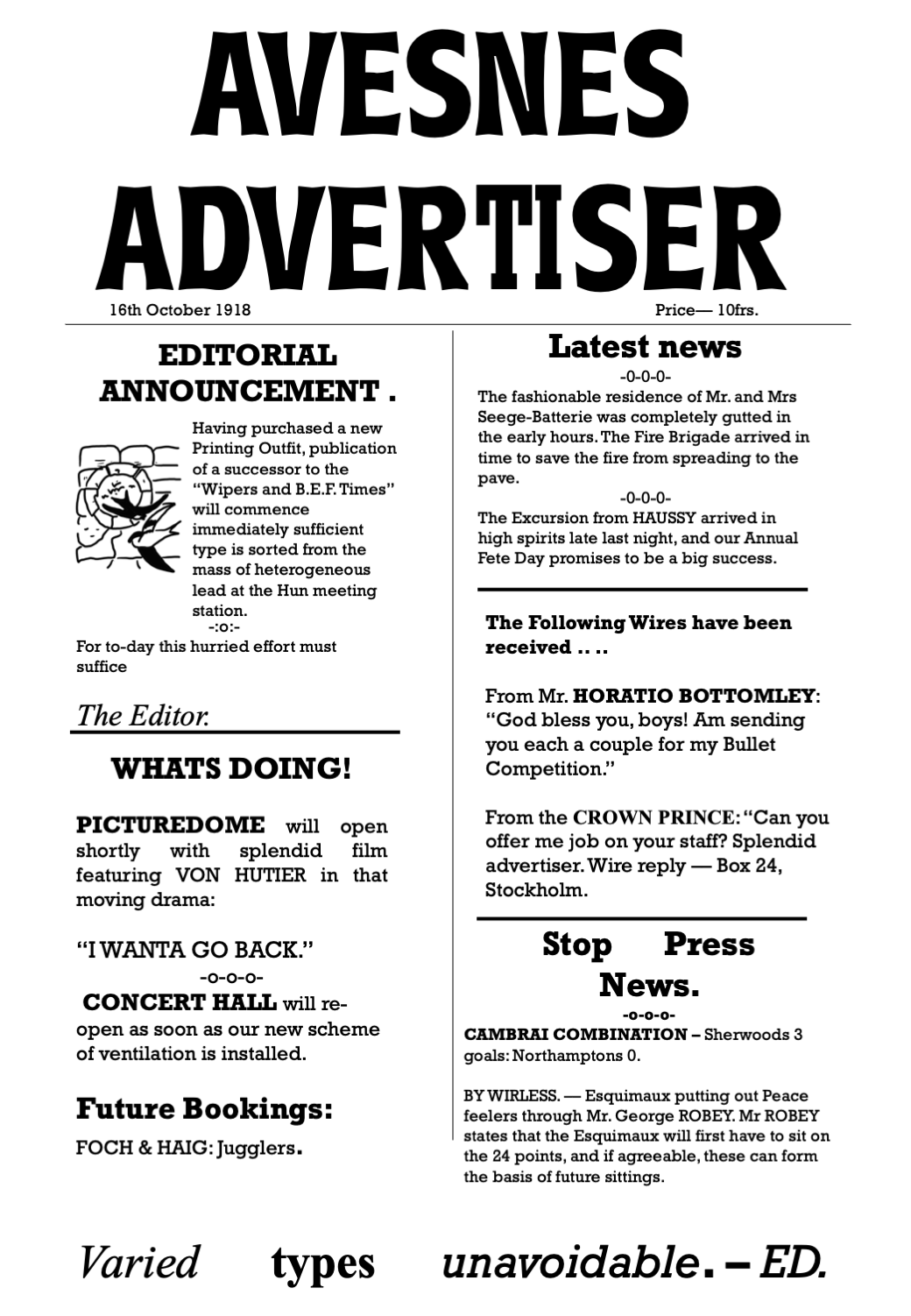
I believe there is a 'when' missing from the opening paragraph, following the word immediately — perhaps falling shells does equal printer errors.
In Roberts' article, he mentions that the football score was a real game played during a short interval during the advance, and Mr and Mrs Seege-Batterie refers to a too-adventurous batch of heavies who had "copped a packet" (Heavy: slang for large calibre howitzer or cannon; Copped a packet: slang for being killed).
-
The Better Times, November 1918, p.1. ↩︎
-
http://www.philsp.com/homeville/fmi/k02/k02470.htm#A6, retrieved 9 October 2023. ↩︎
-
Soulby's Ulverston Advertiser and General Intelligencer, 29 June 1899, p.7. ↩︎
-
Liverpool Mercury, 19 May 1903, p.12. ↩︎
-
National School Admission Registers & Log-Books 1870-1914; The Glasgow University Calendar (Glasgow: University of Glasgow, 1908), p.465, 486. ↩︎
-
Derby Daily Telegraph, 1 March 1918, p.4 ↩︎
-
Bradford Daily Telegraph, 22 August 1914, p.3. ↩︎
-
The Stage, 10 September 1914, p.12. ↩︎
-
The Stage, 15 October 1914, p.11; Evening Echo (Cork), 14 November 1914, p.2; Croydon Times, 29 September 1915, p.1. ↩︎
-
The Era, 25 October 1916, p.8. ↩︎
-
Surrey Advertiser, 4 November 1916, p.7. ↩︎
-
Sussex Daily News, 6 October 1917, p.5. ↩︎
-
Christopher B. Balme, The Globalization of Theatre 1870-1930: The Theatrical Networks of Maurice E. Bandmann (Cambridge: Cambridge University Press, 2020), pp.1-2. ↩︎
-
C. B. Balme, The Globalization of Theatre, p.163. ↩︎
-
Civil & Military Gazette (Lahore), 29 May 1921, p.9 https://www.joydiv.org/familygoingback/career.htm, retrieved 21 September 2023. ↩︎
-
India, Select Marriages, 1792-1945. ↩︎
-
https://www.joydiv.org/familygoingback/career.htm, retrieved 23 September 2023. ↩︎
-
Civil & Military Gazette (Lahore), 27 May 1921, p.7*; The Billboard*, 20 November 1917, p.41. ↩︎
-
C. B. Balme, The Globalization of Theatre, p.134. ↩︎
-
C. B. Balme, The Globalization of Theatre., p.171. ↩︎
-
C. B. Balme, The Globalization of Theatre, p.157-158. ↩︎
-
C. B. Balme, The Globalization of Theatre, p.169. ↩︎
-
C. B. Balme, The Globalization of Theatre, p.174. ↩︎
-
C. B. Balme, The Globalization of Theatre, p.173; ↩︎
-
C. B. Balme, The Globalization of Theatre, p.164. ↩︎
-
Hastings & St Leonards Observer, 11 February 1922, p.1; The Era, 23 May 1923, p.15;1946-1954 Copyright Registration Cards (A-N); Copyright Registration Cards 1946-1954(0-Z). ↩︎
-
The Sketch, 11 April 1923, p.33; The Stage, 8 May 1924, p.26. ↩︎
-
TNA/Divorce Court File 8377. Appellant Violet Alice Blyth Twiss. Respondent: Josiah Oliver Twiss, 1925. ↩︎
-
Tunbridge Wells Opera, 13 September 1929, p.5; The Stage, 31 October 1929, p.6. ↩︎
-
https://www.imdb.com/title/tt0127196/?ref_=nm_knf_t_1, retrieved 21 September 2023. ↩︎
-
The Stage, 14 July 1932, p.10. ↩︎
-
Daily News (London), 25 July 1932, p.6. ↩︎
-
Yorkshire Post and Leeds Intelligencer, 9 May 1933, p.4. ↩︎
-
Daily News (London), 27 July 1932, p.8. ↩︎
-
Wellcome Collection, J O TWISS, SA.EUG/C.342; Annual Report 1932-33, Eugenics Society (London, England), p.13. ↩︎
-
Donald Mackenzie, 'Eugenics in Britain', Social Studies of Science, 6 (24) (1976), pp.500-501 ↩︎
-
Richard Carr & Bradley W. Hart, 'Old Etonians, Great War demographics and the interpretations of British Eugenics, c.1914-1939, First World War Studies, 3 (2) (2012), pp-217-239. ↩︎
-
D. Mackenzie, 'Eugenics in Britain', pp.517-520. ↩︎
-
See http://belmore.altervista.org/, retrieved 28 September 2023. ↩︎
-
http://belmore.altervista.org/jessie-belmore-garstin/; The Stage, 27 April 1950. ↩︎
-
UK Patent GB472818A, 26 March 1936, published 27 September 1937. ↩︎
-
The Stage, 24 August 1939, p.10; The Stage, 29 July 1942, p.1; Aberdeen Press and Journal, 29 April 1943 ↩︎
-
https://web.archive.org/web/20090130215834/http://ftvdb.bfi.org.uk/sift/title/332753?view=synopsis, retrieved 26 September 20213. ↩︎
-
https://www.imdb.com/title/tt1132173/?ref_=nm_flmg_t_1_act, retrieved 14 October 2023. ↩︎
-
The Stage, 27 April 1950, p.9; The Stage, 4 March 1954, p.9. ↩︎
-
https://dictionary.sensagent.com/British%20Catholic%20Stage%20Guild/en-en/, retrieved 29 September 2023. ↩︎
-
Ann Marie Adams, 'Look Back in Realism: The Making and Unmaking of Dramatic Form in the Reception of the British New Wave', The Journal of the Midwest Modern Language Association, 40(1) (2007), p.35. ↩︎
-
The Stage, 13 January 1955, p.8,13. ↩︎
-
The Stage, 29 October 1951, p.5; The Era, 6 March 1909, p.1; Daily Mirror, 4 October 1963, p.22; East Sussex, England, Electoral Registers, 1705-1963; London, England, Electoral Registers 1832-1965. ↩︎
-
England & Wales Government Probate Death Index 1858-2019. ↩︎
-
Cassell's Magazine, Volume 224, November 1931, pp.20-22 ↩︎
-
TNA/W0-95/2201, The war Diary of the 12th Battalion Sherwood Foresters. ↩︎
-
This is mentioned in Patrick Beaver's notes that accompany the 1973 facsimile version. Beaver mentions that the marble was from a broken sink, a detail missing from this account, which makes me wonder if there is another article out there? Beaver (ed.), The Wipers Times: A Complete Facsimile of the famous World War One Trench Newspaper (London: Peter Davies, 1973), p.xix. ↩︎
-
History of the Ministry of Munitions Volume 7: The Control of Materials (HMSO, 1922), p.14. ↩︎
Posts in this series
- The Wipers Times Exposé: A Picture of Dorothy Violet Hall emerges
- The Wipers Times Exposé: The Actor, Avesnes, and the Forgotten Evening Edition of the Wipers Times
- The Wipers Times Exposé: The Printer and the Presses
- The Wipers Times Exposé: Staff, Suspects, and Witnesses
- The Wipers Times Exposé Addendum: Conclusive Proof, the Letters of Thomas Moore Emmanuel Ward, and Other Contributors Identified
- The Wipers Times, Tatler, and the Identity of ‘Violet’ from Violet’s Chronicle of Fashion: An Exposé